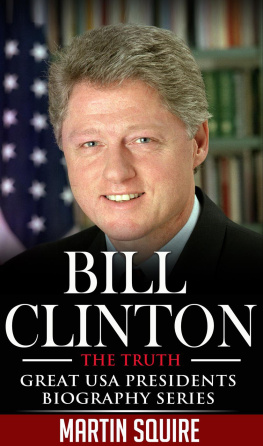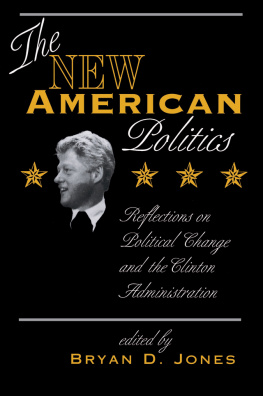Cover

| title | : | From the Center to the Edge : The Politics and Policies of the Clinton Presidency |
| author | : | Berman, William C. |
| publisher | : | Rowman & Littlefield |
| isbn10 | asin | : | 0847696154 |
| print isbn13 | : | 9780847696154 |
| ebook isbn13 | : | 9780585382999 |
| language | : | English |
| subject | United States--Politics and government--1993-2001, Clinton, Bill,--1946- , Political culture--United States--20th century, United States--Foreign relations--1993-2001, United States--Economic policy--1993- |
| publication date | : | 2001 |
| lcc | : | E885.B467 2001eb |
| ddc | : | 979.929/092 |
| subject | : | United States--Politics and government--1993-2001, Clinton, Bill,--1946- , Political culture--United States--20th century, United States--Foreign relations--1993-2001, United States--Economic policy--1993- |
Page i
FROM THE CENTER TO THE EDGE
Page ii
This page intentionally left blank.
Page iii
FROM THE CENTER TO THE EDGE
The Politics and Policies of the Clinton Presidency
WILLIAM C. BERMAN

Page iv
ROWMAN & LITTLEFIELD PUBLISHERS, INC.
Published in the United States of America
by Rowman & Littlefield Publishers, Inc.
4720 Boston Way, Lanham, Maryland 20706
www.rowmanlittlefield.com
12 Hids Copse Road
Cumnor Hill, Oxford OX2 9JJ, England
Copyright 2001 by Rowman & Littlefield Publishers, Inc.
All rights reserved. No part of this publication may be reproduced, stored in a retrieval system, or transmitted in any form or by any means, electronic, mechanical, photocopying, recording, or otherwise, without the prior permission of the publisher.
British Library Cataloguing in Publication Information Available
Library of Congress Cataloging-in-Publication Data Available
ISBN 0-8476-9614-6 (cloth : alk. paper)
ISBN 0-8476-9615-4 (paper : alk. paper)
Printed in the United States of America
 The paper used in this publication meets the minimum requirements of American National Standard for Information SciencesPermanence of Paper for Printed Library Materials, ANSI/NISO Z39.48-1992.
The paper used in this publication meets the minimum requirements of American National Standard for Information SciencesPermanence of Paper for Printed Library Materials, ANSI/NISO Z39.48-1992.
Page v
Contents
Acknowledgments | vii |
Introduction | |
1 From Little Rock to Washington | |
2 From Winning to Losing | |
3 Clintons Comeback | |
4 From the Center to the Edge | |
5 Seeking a Legacy | |
Conclusion | |
Bibliographical Essay | |
Index | |
About the Author | |
Page vi
This page intentionally left blank.
Page vii
Acknowledgments
Steve Wrinn, executive editor for history and political theory at Rowman & Littlefield, was a constant source of encouragement and good advice while I prepared this manuscript for publication. Lynn Gemmell and Mary Carpenter of Rowman & Littlefield also provided valuable assistance. Historians Robert Cuff and Jacob Vander Meulen provided a searching read and did much to improve the manuscripts flow and organization. Leo Ribuffo, a reader for Rowman & Littlefield, was helpful and encouraging. Professor Stanley Kutler gave informed answers to my questions whenever I sought him out on a particular matter bearing on this project. I alone am responsible for what appears in this book.
My wife, Deborah, wasas alwayssupportive and sustaining throughout the writing process. As so often in the past, our family cats, Samantha and Mingus, were on the scene to help with the composition.
This work is dedicated to Berneice K. Smiththe first lady of Berea, Ohioand to Benjamin and Joshua, my grandsons, for whom a bright future beckons.
Page viii
This page intentionally left blank.
Page ix
Our burden is to give the people a new choice, rooted in old values, a new choice that is simple, that offers opportunity, demands responsibility, gives citizens more say, provides them responsive governmentall because we recognize that we are a community, we are all in this together, and we are going up or down together.
Bill ClintonMay 1991
The era of big government is over.
January 1996
I did not have sexual relations with that woman, Miss Lewinsky.
January 1998
Theres a lot to be said for showing up every day and trying to push the rock up the hill.... If you are willing to win in inches as well as feet, a phenomenal amount of positive things can happen.
Summer 2000
Page x
This page intentionally left blank.
Page 1
Introduction
When Bill Clinton was sworn in as president on January 20, 1993, Democrats everywhere sighed with relief. Based on his 1992 campaign, Clinton appeared to have a positive and well-thought-out agenda for coping with the myriad social and economic problems that had festered during the ReaganBush era. Now, perhaps, he would lay the groundwork for the reestablishment of Democratic hegemony in national politics, which had been lost since Richard Nixons election in 1968.
As a result of the social, racial, and cultural strife of the 1960s, which later dovetailed with the deeply rooted economic malaise of the Carter years (197781), the coalition constituted by Franklin D. Roosevelt had been ripped apart, thereby preparing the way for the ReaganBush era in American politics. Throughout the 1980s, Democrats, in their quest of the presidency, lacked both the political means and the agenda to overcome Ronald Reagans brand of charismatic conservatism. The question thus arose: How could Democrats shape a new and more appealing message in an attempt to revive the partys presidential prospects? Bill Clinton, politically skilled and ideologically ambidextrous, appeared to have the answer. He was the chief messenger of a newly fashioned Democratic alternative to the older and now seemingly discredited liberalism of Lyndon Johnsons Great Society.
After taking power on behalf of an agenda for change, Clinton soon encountered serious political difficulties, which eventually brought about a congressional Republican resurgence. Nevertheless,
Page 2
while protecting government from extremist attacks, he managed to salvage his political career, withstanding even impeachment during his turbulent second term. And thanks to a booming economy and a budget surplus, he was able to push an activist agenda to the fore in a way that eventually created the context for the general election in 2000.
Here, then, is a story, full of ironic twists and turns, of a president whose mixed record of accomplishment and failure illuminates the point that the historical process is never static and that it unfolds in ways that are often unanticipated. In this particular case, the narrative focuses on the possibilities for progress as well as the constraints, personal and institutional, that defined the limits of the achievable in a political era still dominated by Reagans mistrust of government. Whether Clinton tried to exercise leadership to shift the balance in a different direction and failed to accomplish very much because of the larger political obstacles he faced, or whether he was only too willing to play the cards he was dealt out of a sense of hard political practicality are matters that will be raised in the pages that follow.
Next page











 The paper used in this publication meets the minimum requirements of American National Standard for Information SciencesPermanence of Paper for Printed Library Materials, ANSI/NISO Z39.48-1992.
The paper used in this publication meets the minimum requirements of American National Standard for Information SciencesPermanence of Paper for Printed Library Materials, ANSI/NISO Z39.48-1992.